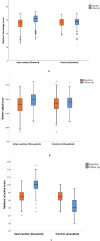Effectiveness of health promotion regarding diet and physical activity among Nepalese mothers and their young children: The Heart-health Associated Research, Dissemination, and Intervention in the Community (HARDIC) trial
- PMID: 31573416
- PMCID: PMC6781231
- DOI: 10.1080/16549716.2019.1670033
Effectiveness of health promotion regarding diet and physical activity among Nepalese mothers and their young children: The Heart-health Associated Research, Dissemination, and Intervention in the Community (HARDIC) trial
Abstract
Background: Nepal, like many low- and middle-income countries, exhibits rising burden of cardiovascular diseases. Misconceptions, poor behavior, and a high prevalence of risk factors contribute to this development. Health promotion efforts along with primary prevention strategies, including risk factor reduction in both adults and children, are therefore critical. Objectives: This study assessed the effectiveness of a health promotion intervention on mothers' knowledge, attitude and practice (KAP) and their children's behavior regarding diet and physical activity. Methods: The Heart-health Associated Research, Dissemination and Intervention in the Community (HARDIC), a community-based trial, used peer education to target mothers with 1-9-year-old children in the peri-urban Jhaukhel-Duwakot Health Demographic Surveillance Site, Nepal, during August-November 2016. In the intervention area, 47 peer mothers were trained to conduct four education classes for about 10 fellow mothers (N = 391). After 3 months, all eligible mothers in the intervention and control areas were interviewed and the results were compared with the KAP of all eligible mothers at baseline. Results: Post-intervention, mothers' KAP median scores had improved regarding heart-healthy diet and physical activity. More mothers had 'good' KAP (>75% of maximum possible scores), and mothers with 'good' knowledge increased from 50% to 81%. Corresponding control values increased only from 58% to 63%. Mothers' attitude and practice improved. Additionally, mothers in the intervention area reported improvement in their children's diet and physical activity behavior. Moreover, Difference in Differences analysis showed that the HARDIC intervention significantly increased mothers' KAP scores and children's behavior scores in the intervention area compared to the control area. Conclusions: Our intervention improves KAP scores regarding diet and physical activity and shows potential for expansion via community health workers, volunteers, and/or local women. Moreover, HARDIC can contribute to Nepal's Package of Essential Noncommunicable Diseases Initiative, which currently lacks a specific package for health promotion.
Keywords: Diet; health promotion; mothers; physical activity; young children.
Figures




References
-
- Rayner M, Mendis S.. An introduction to population-level prevention of non-communicable diseases. Oxford, UK: Oxford University Press; 2017.
-
- Mendis S. Global status report on noncommunicable diseases 2014. Geneva: World Health Organization; 2014. [cited 2015 February] Available from: https://www.who.int/nmh/publications/ncd-status-report-2014/en/ - PubMed
-
- Hallal PC, Andersen LB, Bull FC, et al. Global physical activity levels: surveillance progress, pitfalls, and prospects. Lancet. 2012;380:247–257. - PubMed
-
- World Health Organization Global health risks: mortality and burden of disease attributable to selected major risks. Geneva: World Health Organization; 2009. [cited 2014 June] Available from: http://origin.who.int/healthinfo/global_burden_disease/GlobalHealthRisks...
Publication types
MeSH terms
LinkOut - more resources
Full Text Sources
Medical
